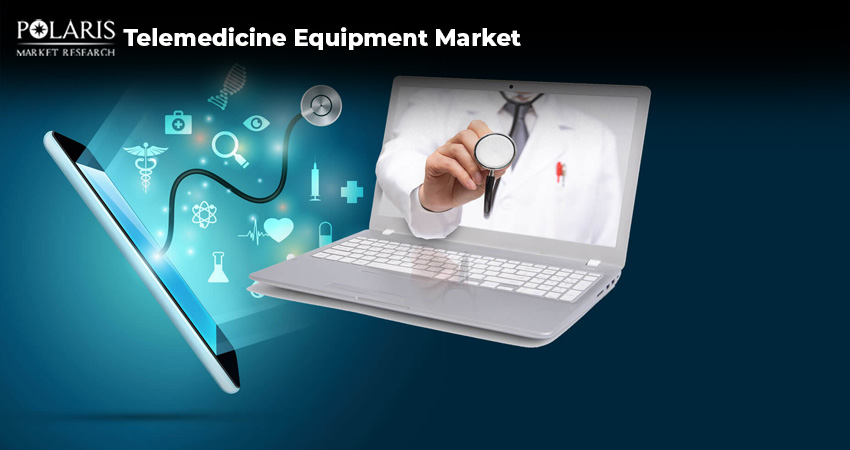Market Leaders Influencing the Future of Telemedicine Equipment Market in 2025

The rapid evolution of healthcare technology has transformed the way medical services are delivered, with telemedicine emerging as a game-changer. Telemedicine enables healthcare professionals to diagnose, monitor, and treat patients remotely using advanced digital tools and medical devices. From portable diagnostic devices to advanced communication tools, these technologies are reshaping how healthcare is delivered, especially in underserved and remote areas.
This blog explores the importance of telemedicine equipment, its diverse applications, the opportunities and challenges it presents, future trends, and the key companies driving innovation in this space. Join us as we delve into the world of telemedicine and its potential to redefine healthcare.
Importance of Telemedicine
Telemedicine equipment is the backbone of virtual healthcare that allows seamless communication and data exchange between patients and healthcare providers. These tools are essential for delivering high-quality care to patients and healthcare providers. These tools are essential for high-delivery care to patients who cannot access traditional healthcare facilities due to geographical, financial, or mobility reasons. Moreover, telemedicine equipment enhances efficiency in healthcare delivery. By enabling early diagnosis and continuous monitoring, telemedicine equipment improves patient outcomes and reduces healthcare costs.
Applications of Telemedicine Equipment
- Teleconsultations and Virtual Visits: Doctors can conduct remote telehealth consultations using HD cameras, digital stethoscopes, and AI-powered diagnostic tools. Teleconsultations and virtual visits are rapidly growing in the telemedicine market, offering remote healthcare access through technology, including video conferencing and messaging, for consultations, advice, and treatments, expanding healthcare access and improving efficiency.
- Remote Patient Monitoring (RPM): RPM involves using digital devices and technology to collect and transmit patient-generated health data (PGHD) to healthcare providers for assessment, recommendations, and instructions. Remote patient monitoring devices like wearable ECG monitors, pulse oximeters, and blood pressure monitors help track patients’ health in real-time.
- Tele-ICU and Emergency Care: Tele-ICU and emergency care telemedicine are growing sectors, leveraging technology for remote monitoring and management of critically ill patients, particularly in underserved areas. Emergency medical teams use telemedicine equipment to connect with specialists during critical cases.
- Mental Health and Behavioral Therapy: Online therapy sessions and AI-driven mental health chatbots provide support to patients struggling with mental health issues. Wearable devices track stress levels, sleep patterns, and heart rate variability to offer personalized mental health recommendations.
- Chronic Disease Management: Devices like glucose monitors, ECG machines, and wearable fitness trackers enable continuous monitoring of patients with conditions such as diabetes, hypertension, and heart disease. Data collected from these devices can be shared with healthcare providers in real-time, facilitating timely interventions.
Emerging Trends in Telemedicine Equipment
- Augmented Reality (AR) and Virtual Reality (VR) in Healthcare: VR and AR technologies have the potential to transform telemedicine by enabling immersive virtual consultations and remote surgical assistance.
- AI-Powered Virtual Assistants: AI-driven virtual assistants will enhance telemedicine by providing automated diagnosis, appointment scheduling, and patient education.
- Wearable Technology: The development of advanced wearable devices, such as smartwatches and biosensors, will revolutionize remote patient monitoring by providing continuous, real-time health data.
- 5G-Enabled Telehealth: The global rollout of 5G networks will enhance the speed and reliability of telemedicine services, enabling real-time transmission of high-quality video and data.
Key Companies in Telemedicine Equipment Market
Founded: 2002 (Dallas, Texas)
Headquarters: Purchase, New York, USA
Teladoc Health is a virtual healthcare company that provides remote medical care through videoconferencing, mobile apps, and the phone. Teladoc offers a variety of services, including primary care, mental health, and chronic condition management. Teladoc offers a comprehensive telemedicine platform that includes video consultations, remote monitoring, and AI-driven diagnostics. Teladoc has doubled the number of free care visits delivered to communities impacted by natural disasters.
- American Well (Amwell)
Founded: 2006
Headquarters: Boston, Massachusetts, USA
Amwell, which was formerly known as American Well, provides a telehealth platform that connects patients with healthcare providers for a wide range of services, from urgent care to chronic disease management. They offer services that include video consultations, remote patient monitoring, urgent care, birth control, and digital health programs. Amwell's software development kits, APIs, and system integrations enable clients to embed telehealth into existing workflows.
Founded: 1891 (Eindhoven, Netherlands)
Headquarters: Amsterdam, Netherlands
Philips Healthcare offers a range of telemedicine solutions, including remote patient monitoring devices and telehealth platforms designed for hospitals and home care. Philips Healthcare operates sustainably to high environmental, social and governance (ESG) standards. They offer services such as clinical applications, consulting, diagnostic technologies, and healthcare informatics.
- GE Healthcare
Founded: 1892
Headquarters: Chicago, Illinois, USA
GE Healthcare is a company that provides medical technologies, devices, and services. Their goal is to improve patient outcomes and make healthcare more efficient. Their services range from medical imaging and patient monitoring to drug discovery and pharmaceutical diagnostics. GE Healthcare's researcher William Coolidge developed the hot-cathode, high-vacuum X-ray tube in 1913. The basic design of the Coolidge tube is still in use today.
- Medtronic
Founded: 1949
Headquarters: Dublin, Ireland
Medtronic is well-known for its medical devices. Medtronic plays a significant role in analytical testing within the medical device industry by utilizing advanced data analysis techniques to evaluate the performance and safety of their medical devices. Medtronic has ventured into telemedicine with solutions for remote monitoring of chronic conditions such as diabetes and cardiovascular diseases allowing healthcare providers to access real-time data from implanted medical devices like pacemakers and insulin pumps.
To Sum It Up
Telemedicine equipment is revolutionizing healthcare by making it more accessible, efficient, and patient-centered. From remote consultations to chronic disease management, its applications are vast and impactful. With continuous advancements in AI, IoT, and telecommunication technology, telemedicine will continue to revolutionize global healthcare in the coming years. As we move forward, telemedicine will undoubtedly play a central role in shaping the future of healthcare.

